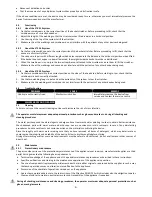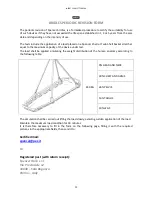
6
Absence of oxidation on buckles
That the movement of any adjustment system slides properly and its fixation is safe
If the above conditions are met, the device may be considered ready for use, otherwise you must immediately remove the
device from service and contact the manufacturer.
4.3
Functioning
4.3.1
Use of the STX 519 system
1.
Fix the four carabineers in the correct position of the basket stretcher. Before proceeding to lift, check that the
carabineers are all correctly hooked on.
2.
Adjust the length of the webbing so that the stretcher when lifted remains in a horizontal position.
3.
Use the ring at the top of the system to lift the stretcher.
4.
Make sure the at the webbings and carabineer do not interfere with the patients of any other devices being used.
4.3.2
Use of the STX 540 system
1.
Fix the four straps with noose to the correct position of the basket stretcher. Before proceeding to lift, check that the
noose are all correctly fitted.
2.
The straps are in pairs with different lengths which helps compensate the balance in the horizontal position when lifted.
If the basket does not appear to be well balanced, the weight inside the basket must be re distributed.
3.
When the carabineer is in use, join the two extremities not attached to the stretcher and use them to lift the stretcher.
4.
Make sure the at the webbings and noose do not interfere with the patients of any other devices being used.
4.3.3
Use of the STX 542 system
1.
Fix the two carabineers into their correct position on the sides of the head area. Before starting to tow, check that the
carabineer are both correctly attached.
2.
Use the two webbing loops to be found at the extremity of the system to tow the stretcher.
3.
Make sure the the webbings and carabineer do not interfere with the patients of any other devices being used.
4.4
Troubleshooting
PROBLEM
CAUSE
REMEDY
Hooks are not correctly fixed
Mechanism is broken
Immediately remove the device from
service and contact the service centre
5.
MAINTENANCE AND CLEANING
5.1
Cleaning
Failure to carry out the correct cleaning routine could increase the risk of cross infection.
The operator must always wear adequate personal protection such as gloves and mask etc. during all checking and
cleaning procedures.
The metal parts exposed to external agents undergo surface treatment and/or painting in order to obtain better resistance.
Wash exposed parts with warm water and mild soap, never use solvents or stain removers. In case of any disinfecting
procedures do not use solvents wih corrosive action on the materials constituting the device.
Rinse thoroughly with warm water making sure that you have removed all traces of detergent, which may deteriorate or
compromise the integrity and durability of the device. Allow to dry thoroughly before storing.
Drying after washing or after use in wet environments must be natural and not forced, do not use flames or other sources of
direct heat.
5.2
Maintenance
5.2.1
Precautionary maintenance
The person who carries out the precautionary maintenance of the appliance (user in person, manufacturer/supplier or a third
party) has to guarantee the following basic requirements:
Technical knowledge of the appliance and of the periodic maintenance procedures as described in these instructions.
Specific qualifications and training in the maintenance operations of the appliance in question.
The use of components/replacement parts/accessories that are either original or approved by the supplier, in such a way
that each operation causes no alteration or modification to the appliance.
Possession of the checklist of operations carried out on the appliance.
Guarantee complete adherence to the instructions of the Directive 93/42/CEE which includes also the obligation towards
the manufacturer to maintain post sales records and traceability of the appliance if requested.
During all checking, maintenance and cleaning procedures, the operator must wear adequate personal protection such as
gloves, mask, glasses etc.













